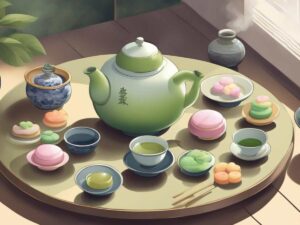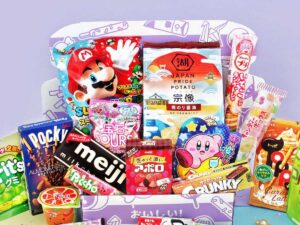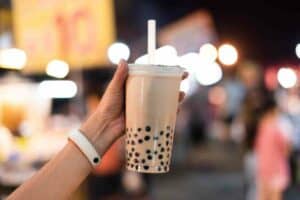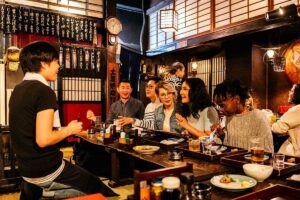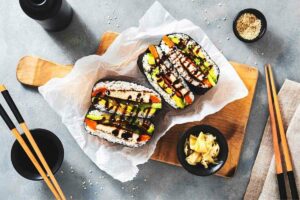You can’t fail to spot donburi dishes on the menu of any Japanese restaurant.
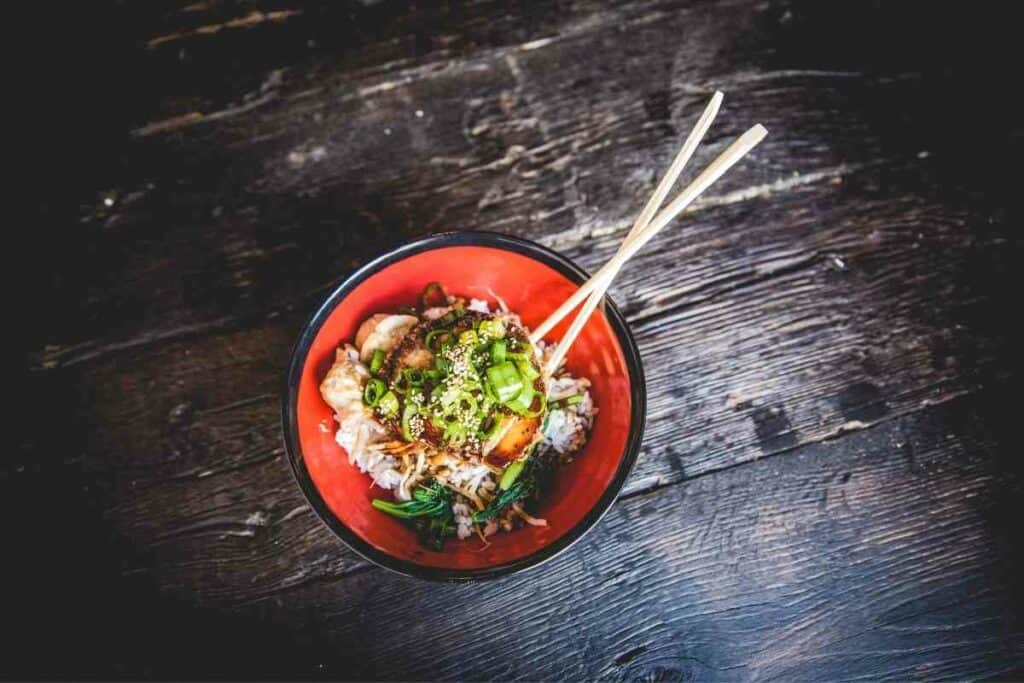
Donburi is undoubtedly one of the ‘most Japanese’ delicacies, consisting of a large rice bowl served with meat, vegetables, sauces, and other ingredients.
It’s a convenient and satisfying all-in-one meal.
Table of Contents
Donburi – What to Expect?
In Japan, rice is usually served in a small bowl, and side dishes are served separately on smaller plates or bowls.
However, donburi is done differently – the rice is put in a deep bowl with a thick body and then topped with your preferred meats, veggies, and other ingredients.
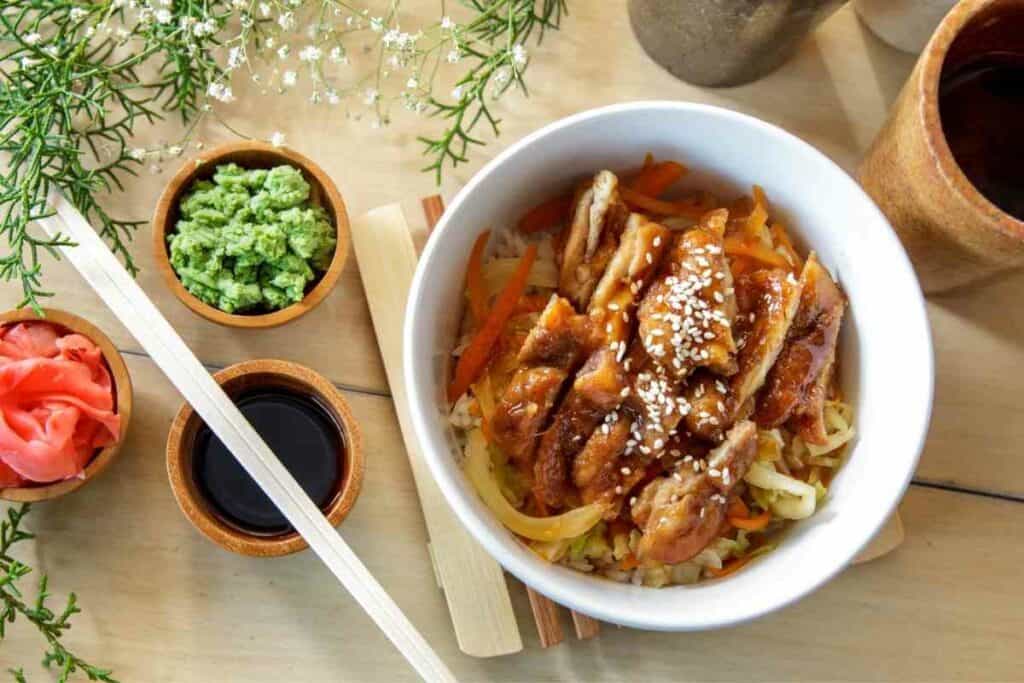
The bowl has a lid to keep the food warm and preserve its aroma.
The name ‘donburi’ originates from a bowl. During the Edo Period, restaurants serving meals in a single bowl were called ‘Kendon-ya.’
The bowls were known as ‘Kendonburi-Bachi.’ Later, the bowls’ name was shorted to ‘donburi-Bachi,’ and then ‘donburi.’
Whenever you visit a Japanese restaurant, try the following delicious donburi recipes. You can even make some yourself.
1. Ten-don
Ten-don combines two words – tempura, fried seafood, and donburi; rice served in a bowl.
It’s an archetypal Japanese meal consisting of deep-fried seafood and vegetables spread over steamed rice.
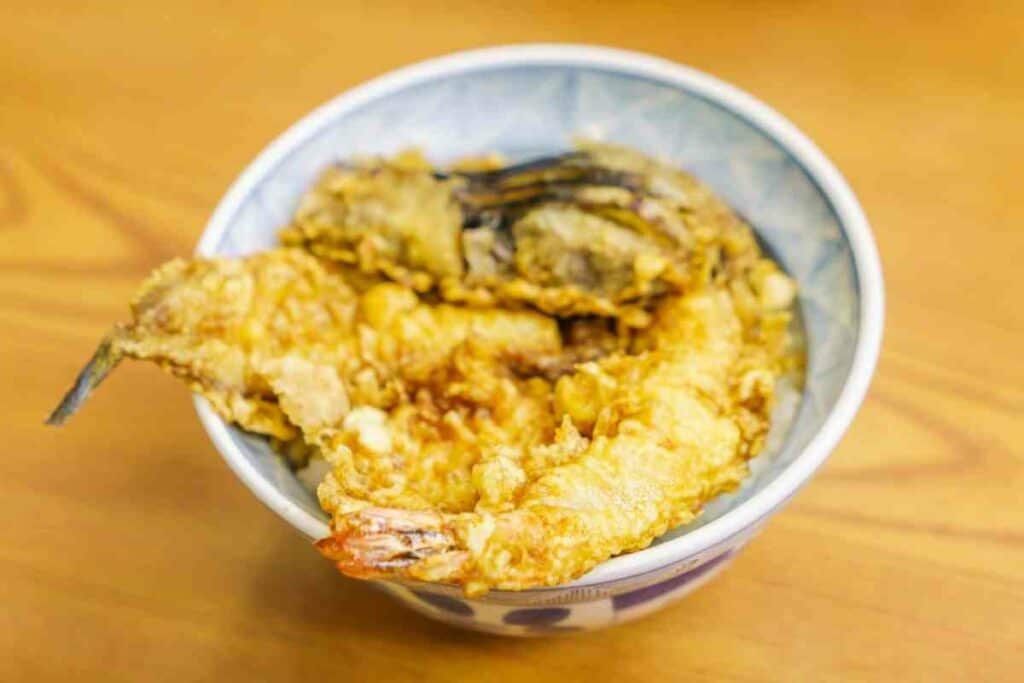
Like other tempura recipes, ten-don comprises shrimps. Other ingredients include Nasu, the Japanese eggplant, and vegetables like radish and squash.
Before serving, the cook sprinkles a flavorful tempura sauce made using dashi soup stock, mirin, soy sauce, and kaeshi sugar.
You can make your donburi dish more inviting by dipping the tempura pieces in the sauce before neatly arranging them over the steamed rice.
Tentamadon is a lesser-known ten-don variant. It consists of tempura simmered in beaten eggs before it is spread over steamed rice.
It’s a delicious mixture of tempura, rice, and scrambled eggs that keeps you full for extended periods.
2. Katsu-don
Katsu-don is a popular donburi dish comprising deep-fried cutlets spread over steamed rice.
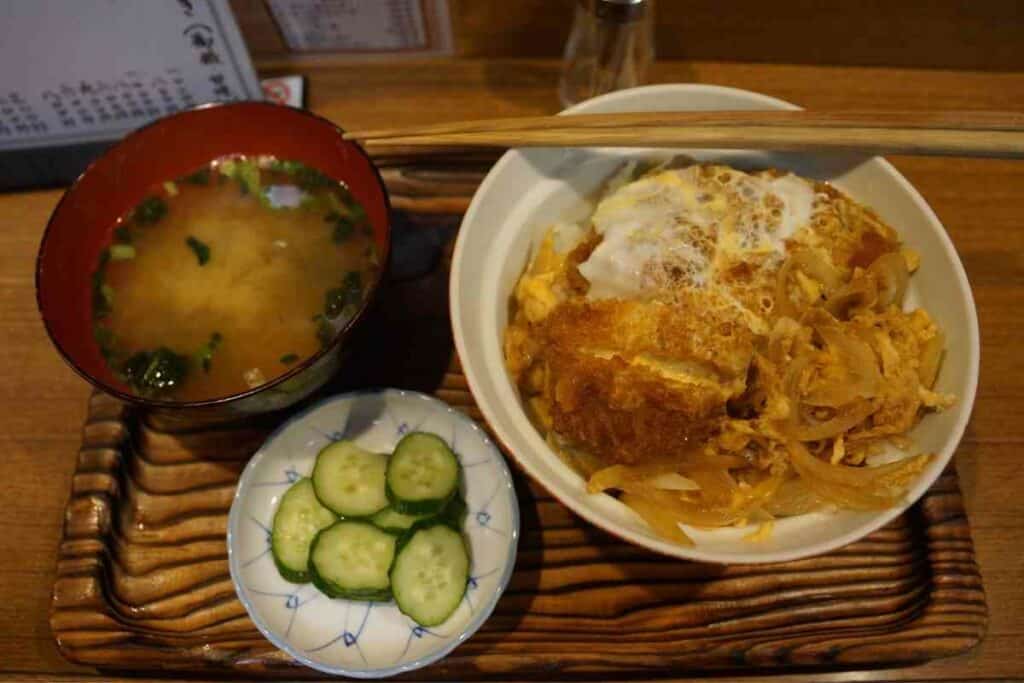
Most recipes use chicken or pork cutlets, but you can also get vegan-friendly options featuring tofu cutlets.
First – The cook simmers the cutlets with eggs, dashi soup stock, and onions, creating a dish with contrasting textures and a delectable taste.
Katsu-don has other variants, albeit less popular. The most common variety is sosu katsu-don, where steamed cabbages replace the eggs.
Then, the cook sprinkles Worcester sauce over the cutlets to make the dish sweeter. Sosu katsu-don is a popular dish in the Fukui Prefecture that’s gaining popularity across Japan.
It’s worth noting that ‘katsu’ means winning in Japanese. For this reason, many people like eating katsu-don when they need good luck, such as before exams.
3. Gyu-don
Gyu-don is one of the most popular donburi dishes worldwide.
It translates to ‘beef bowl’ in English. Many believe that gyu-don originated from gyunabe, a beef hot pot from the Kanto region in eastern Japan.
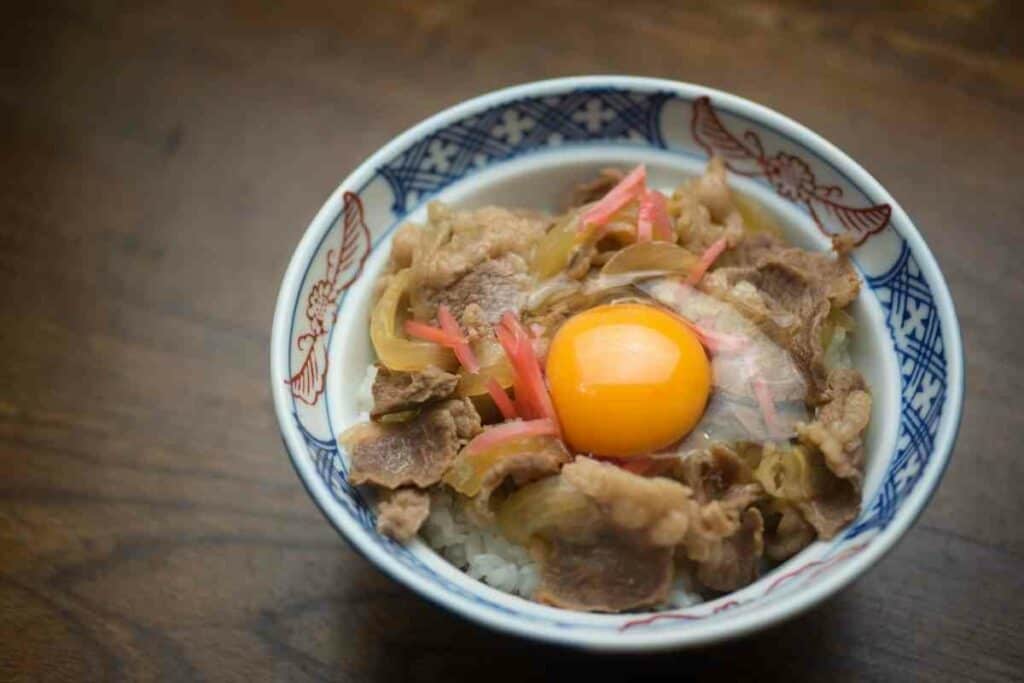
The dish gained popularity across the country after the Great Kanto Earthquake in 1923.
Many people started consuming it since it was available and easy to prepare. Before the tremor, most of its consumers were in the working class.
After Steaming Rice – Simmer thin beef slices and onions with mirin, sake, soy sauce, and sugar. Then, spread the beef and onions over a rice bowl to impart a salty-sweet taste to the dish.
Other ingredients that can add flavor to your gyu-don include grated radish, kimchi, pickled ginger, poached eggs, and red chili.
In restaurants, gyu-don tastes different since you season the dish to suit your preferences.
4. Chuka-don
Chuka-don comprises stir-fried meat, seafood, and vegetables simmered in a starchy, soy-infused sauce and spread over a bowl of steamed rice.
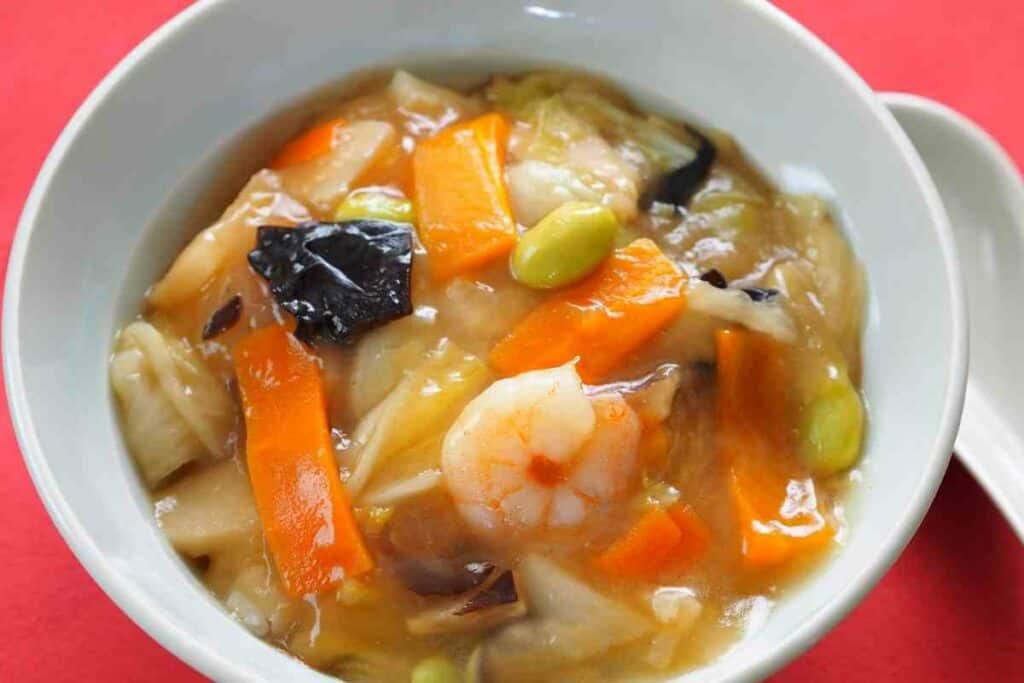
Although ‘Chuka’ means Chinese, this food doesn’t originate in China; it’s non-existent.
Instead, it comes from a dish cooked for restaurant workers in Japanese Chinatowns.
Chuka-don is an everyday recipe in many fast-food establishments in Japan because it’s easy to prepare.
The two most popular Chuka-don varieties are mabo-don, made using tofu and ground pork, and tenshin-don, comprising a crab omelet dipped in thickened sauce.
Vegetable ingredients include steamed cabbages, wood ear mushrooms, and bamboo shoots.
5. Una-don
There are unproven claims that una-don is Japan’s pioneering donburi recipe.
The meal, consisting of grilled eel (unagi) served over rice, is famous for its pleasant aromas and textures.
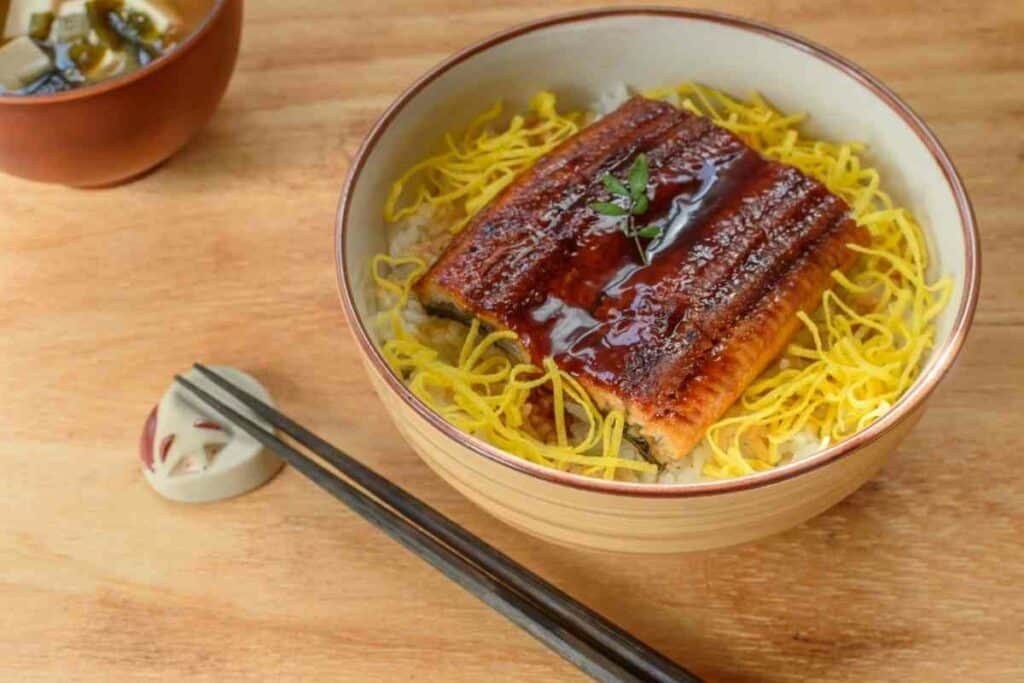
The spicy aroma and rich taste fuel your appetite, making una-don a popular energizer dish for scorching summer afternoons.
Standard preparation involves slathering eel with teriyaki-like sauce and grilling it until it’s crispy.
However, it varies by region. In Kanto, the eel is steamed before grilling to give it a more tender texture.
On the Contrary – Kansai residents grill the fish without steaming. A charcoal-fired grill is best if you want to preserve the flavorful aromas.
Una-don has many variants in different parts of Japan. In Nagoya, locals love hitsumabushi, a donburi recipe featuring una-don with excess spices and soup.
You can choose between Nagasaki (eel and rice served separately) and unajyu (una-don served in a square lacquer container).
6. Oyako-don
Oyako-don is a poetic name meaning father and child.
Oyako combines two terms:
- ‘Oya,’ meaning father
- and ‘ko,’ meaning child
It refers to the dish’s recipe that consists of chicken and eggs, which are ‘father’ and ‘child.’
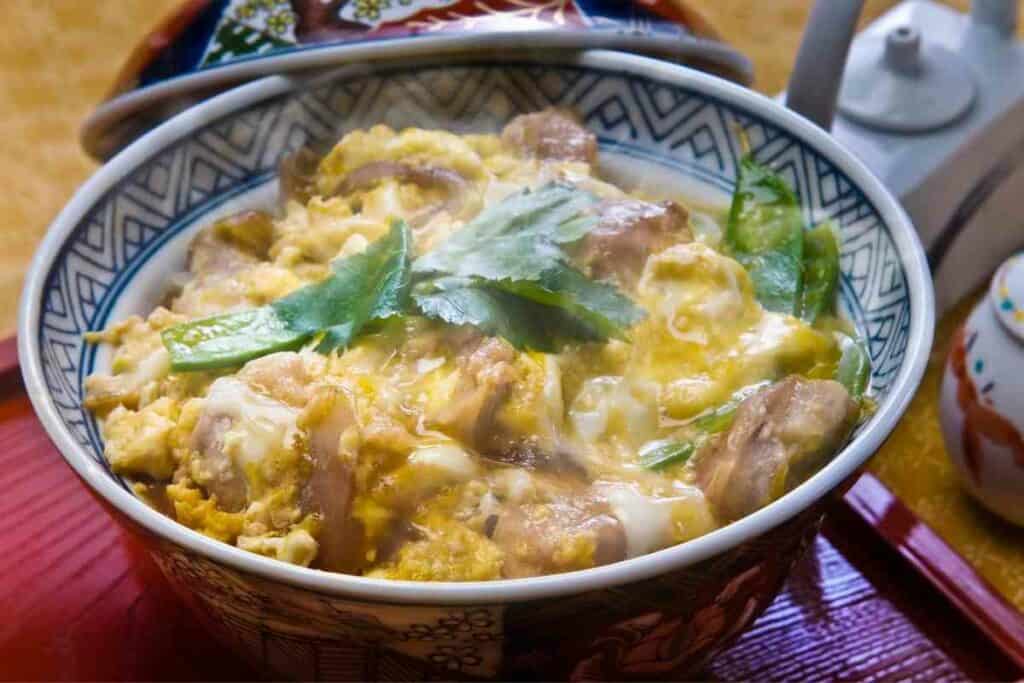
The first oyako-don dishes were served in a restaurant specializing in Shamo chicken in Nihonbashi, Tokyo, during the Meiji Period.
They comprised the day’s leftovers simmered with eggs and spread over boiled rice. The dish gained popularity and is still a favorite to date.
Modern oyako-don consists of a bowl of rice topped with:
- chicken
- chopped scallions
- and eggs
Preparation involves pouring runny eggs over steaming rice, which solidifies them.
Even Better – Most people consume oyako-don at lunch because it’s easy to prepare. Besides fast-food restaurants, this donburi dish is also typical in roadside food stalls.
7. Kaisen-don
If you love seafood, you might want to try Kaisen-don.
The dish originates from Hokkaido Island and features steamed rice served with thin slices of assorted uncooked seafood called sashimi.
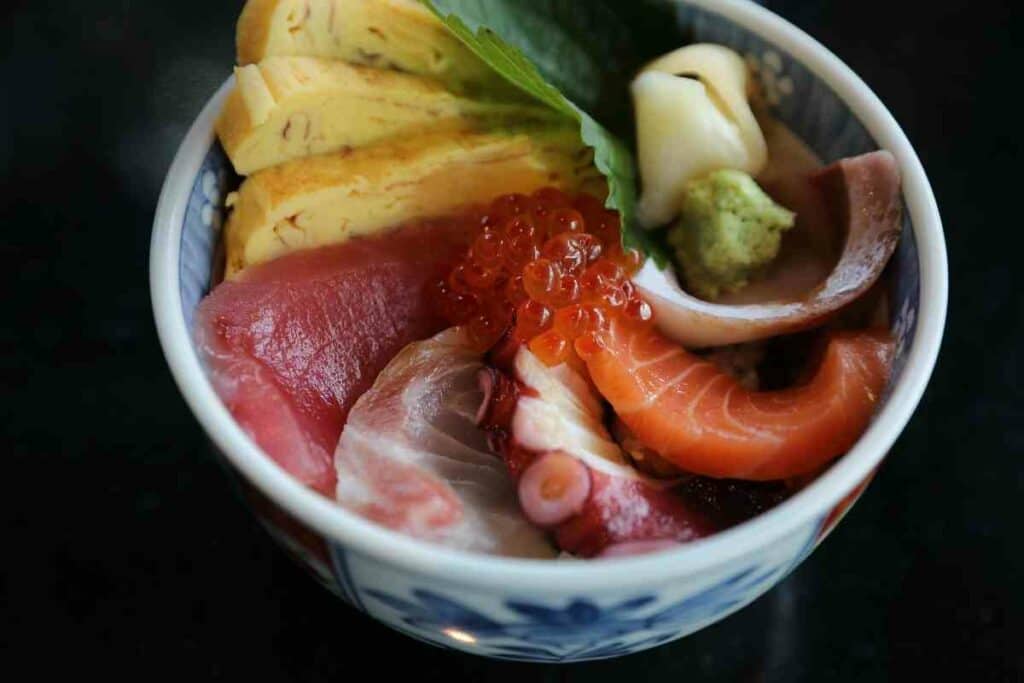
In most cases, sashimi ingredients depend on the location and season.
Common sashimi ingredients include:
- ama ebi (shrimps)
- fresh uni (sea urchin)
- hotate (scallops)
- Kani (crab)
- marinated ikura (salmon roe)
- and tai (sea bream)
You can add toppings like cucumber, ginger, basil, and onions to add flavor to your donburi dish.
Although most Kaisen-don recipes have one seafood type, some combine many seafood types.
One popular example is the combination featuring salmon and salmon roe that creates the seafood equivalent of the oyako-don.
If you don’t like uncooked seafood, Kaisen-don recipes use cooked seafood.
8. Buta-don
Buta-don translates to ‘pork bowl’ in English.
It’s a bowl of rice served with pork cutlets dipped in salty-sweet soy sauce. Other common toppings are green peas and onions.
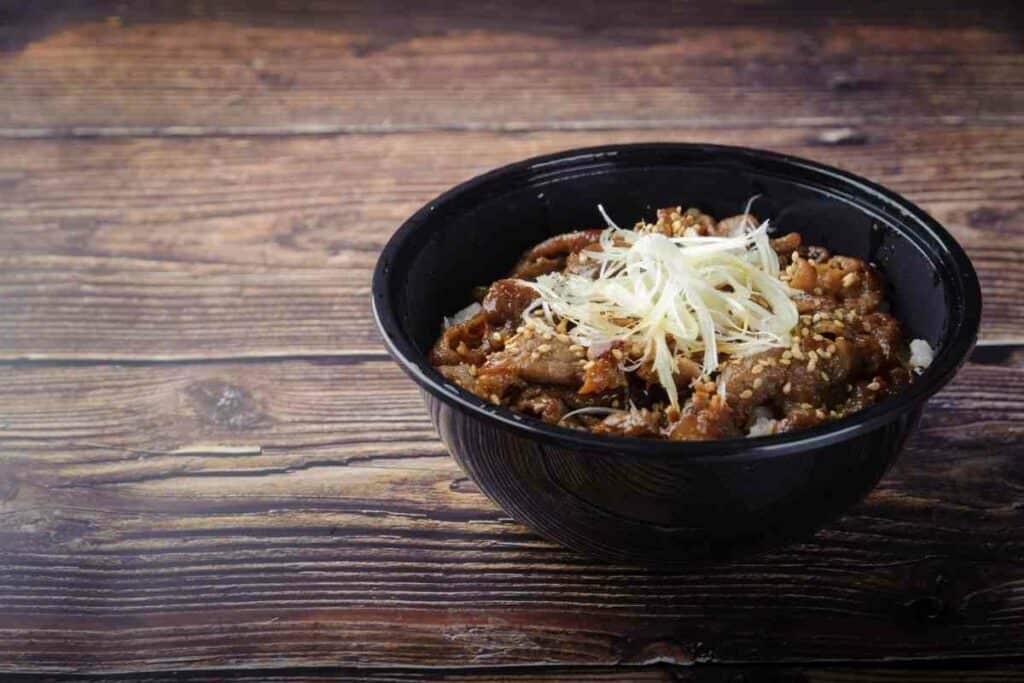
Buta-don is a relatively new donburi dish. Its origins are traced to the Pancho restaurant in Hokkaido in 1933.
The eatery’s owner, Abe, invented Buta-don to encourage pork consumption among the Japanese.
At the start of the 21st century, Japan imposed restrictions on beef consumption.
This prompted people to abandon gyu-don for Buta-don. The restrictions no longer exist, but this pork-based donburi dish is still popular.
Buta-don is the best donburi dish for those who love smoky flavors. Since it has a strong flavor, it’s best served with pickled vegetables.
9. Kare-don
Kare-don consists of Japanese-style curry spread over a bowl of freshly steamed rice.
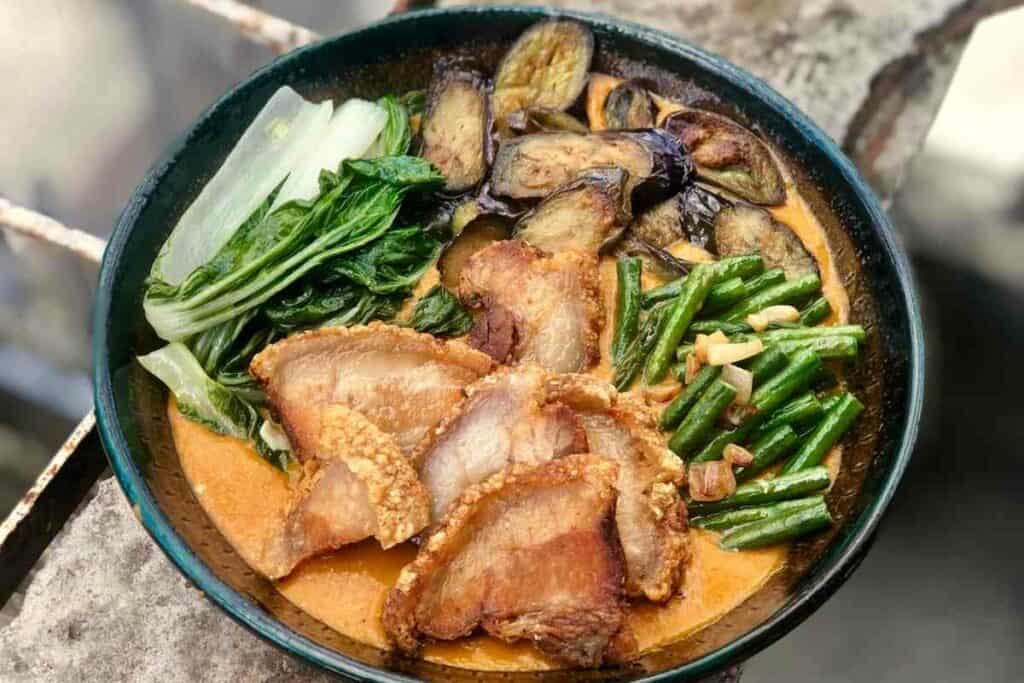
The sauce used is similar to that used to prepare wheat and buckwheat noodles in soba restaurants.
To prepare it, dilute regular curry with dashi soup stock and thicken with potato starch or wheat flour. You can impart more flavors by adding soy sauce.
The preferred meat topping for Kare-don is pork, cut into thin strips and cooked in a vegetable and curry mixture.
You can garnish with peas, shallots, and other green vegetables to enhance the topping’s visual appeal.
Kare-don is simple and easy to prepare, making it a popular choice for working-class Japanese. Most fast-food outlets that sell gyu-don and Buta-don also sell this donburi dish.
10. Ikura-don
As the name suggests, ikura-don is a single-bowl dish consisting of plain rice served with ikura (salmon roe).
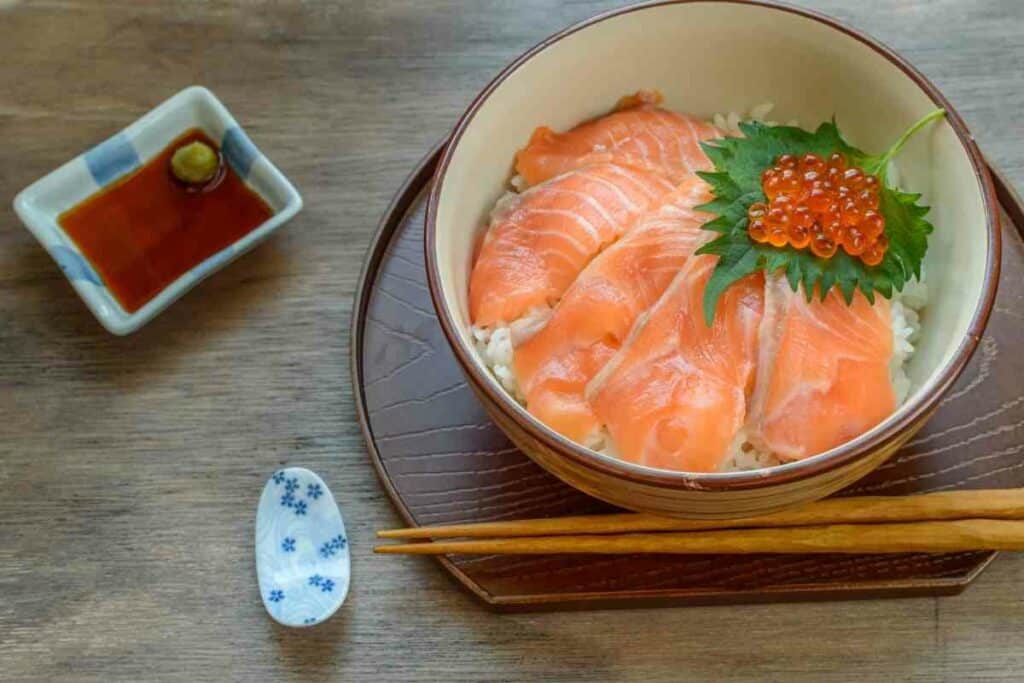
Ikura is a popular addition in many donburi dishes that are mostly marinated in mirin, sake, and soy sauce mixture.
The roe is then spread over the rice, where it can be eaten plain or complemented with dry seaweed or raw egg yolks. Sometimes, restaurants serve crabmeat or salmon sashimi as ikura-don side dishes.
11. Tekka-don
Tekka-don is different from typical donburi dishes because its rice isn’t plain. Instead, it has a vinegar flavor.
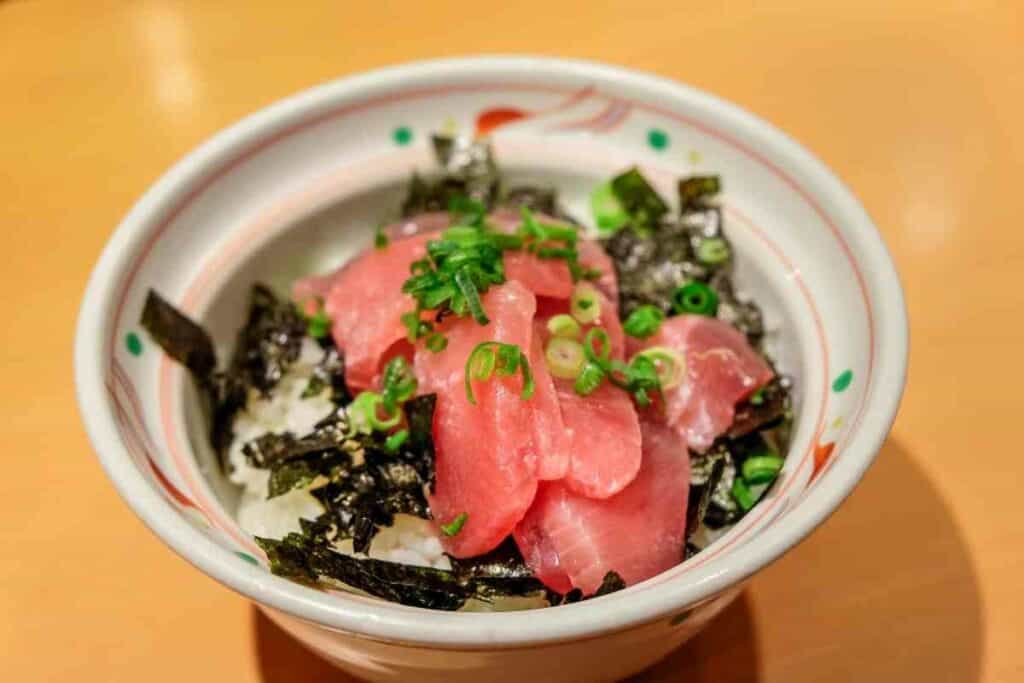
Toppings are sashimi-style uncooked tuna pieces. You can garnish the tuna with dried seaweed and sliced scallions and serve soy sauce on the side.
Tekka-don refers to maguro zoke don, a dish featuring marinated tuna pieces served without sauce. You can consume tekka-don independently or as a light main course.
Final Thoughts
It’s inexcusable to overlook donburi dishes whenever you visit Japan.
Besides variety, these meals are delicious and satiating. Whether you like beef, chicken, pork, or seafood, you’ll get a recipe that suits your taste.
However, eating too much donburi is unhealthy. As seen above, most recipes prioritize meats and eggs over vegetables.
To avoid health complications, always top your donburi with vegetables.
- Japanese Traditional Sweets (Wagashi): A Guide to Their Origins and Varieties
- A Taste of Japan in Every Bite – Japanese Candy & Snack Box Review
- Bubble Tea vs Boba Compared: What’s the Difference?
- Best Izakaya Foods for a Relaxed Night Out (My Top 10 Picks)
- Edo Kiriko Whiskey Glasses (Japanese Heritage in Every Pour)
- Japanese Viral Foods on Social Media (Discover the Top 10)

